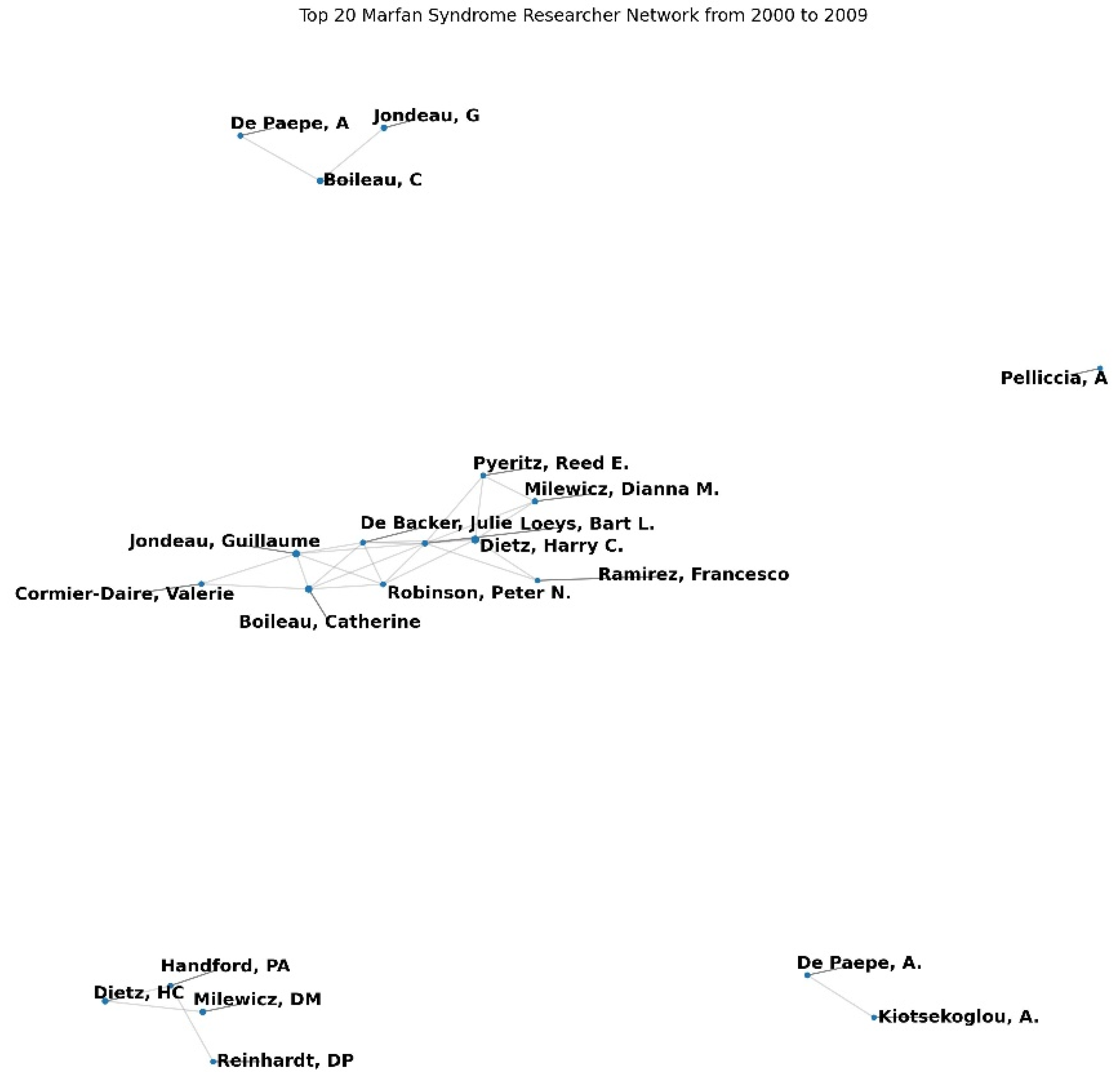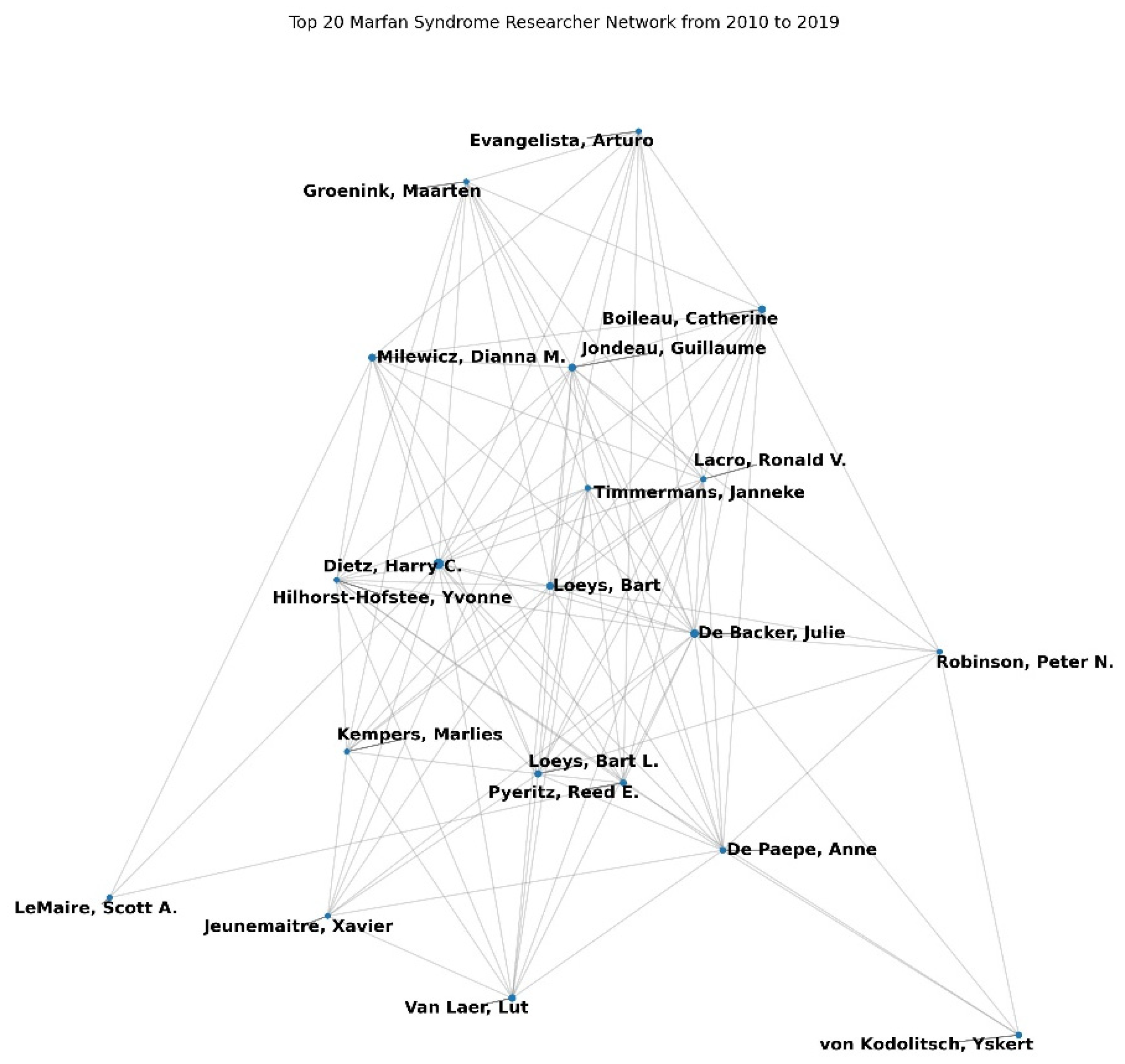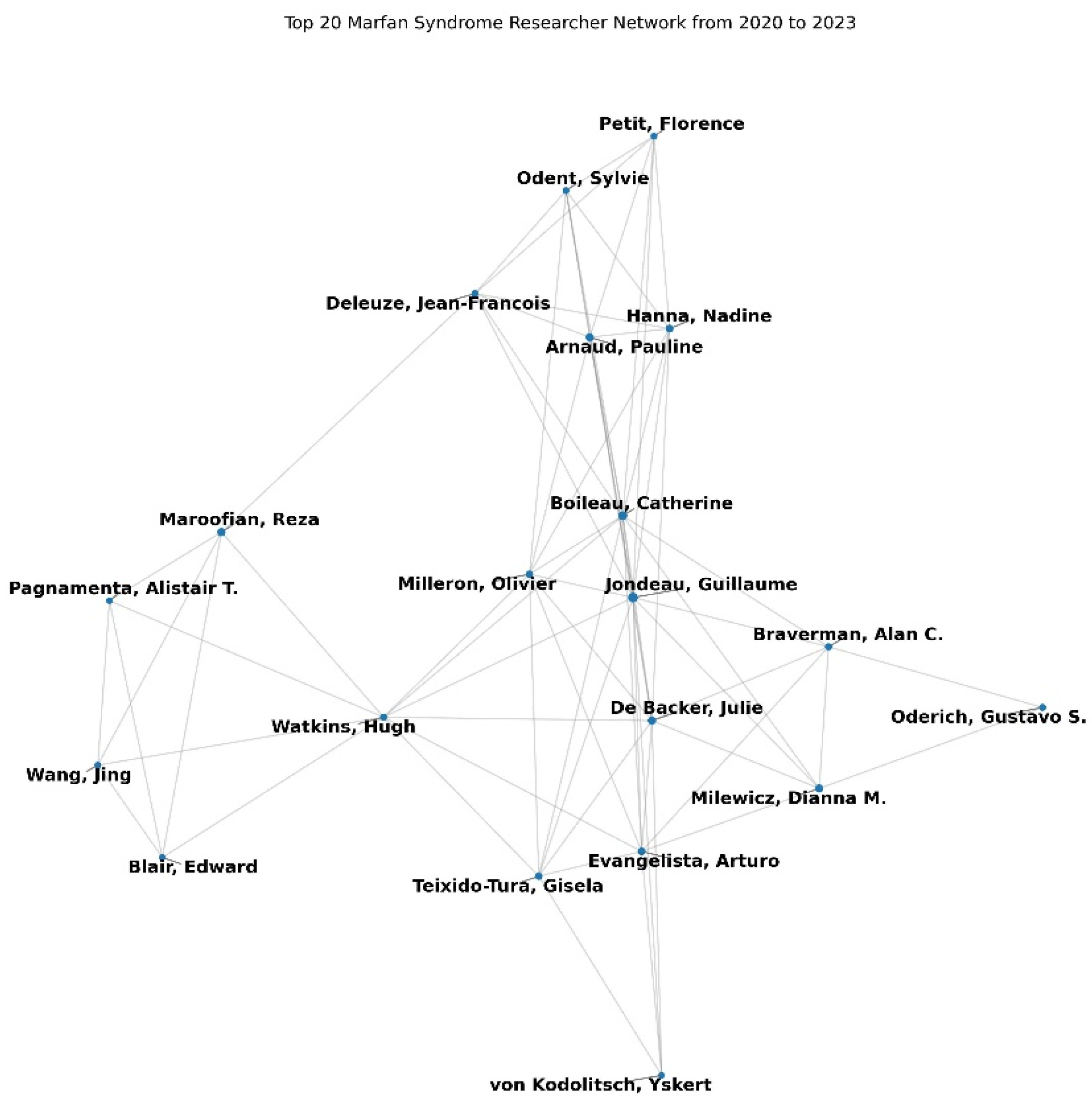Introduction
Background and Objectives
Marfan Syndrome (MFS) is a genetic disorder that affects connective tissue, with complications that can involve the heart, blood vessels, bones, joints, and eyes. The complexity and multi-organ impact of MFS has made it a critical area of medical research. With advancements in genetics, molecular biology, and treatment options, global efforts have increased to understand the disease better and improve patient outcomes. However, despite significant progress, challenges remain in the diagnosis, management, and long-term treatment of MFS, particularly in less-resourced regions [
1,
2].
In terms of scientific collaboration, network analysis provides a powerful method for understanding the structure of research communities and the collaborations that drive innovation. By applying network analysis techniques to the study of co-authorship in MFS research, we can gain insights into how research networks have evolved over time, the key players within these networks, and how collaboration has contributed to advancements in the field.
The global landscape of MFS research grew significantly from 2000 to 2023. This period witnessed the formation of international consortiums and registries, an increase in multi-center studies, and regular global conferences that fostered networking among researchers. Collaborative projects focusing on specific aspects of MFS emerged, while shared databases enhanced research capabilities. This cooperation led to an improved understanding of MFS genetics, clinical aspects, and treatments, positively impacting patient care [4]. The collaborative approach in MFS research now serves as a model for international cooperation in rare disease studies, demonstrating the power of global synergy in addressing complex medical challenges.
Scope of the Study
This study examines publications related to MFS research indexed in the Web of Science (WoS) Core Collection database between 2000 and 2023. A total of 6,657 articles were selected for analysis, providing a comprehensive overview of the collaborative landscape within this specialized field over the past two decades. The dataset ensures the inclusion of the most recent publications (as of September 2024). The analysis will focus on constructing and evaluating co-authorship networks using macro-level indicators such as network density (the ratio of actual to possible connections), clustering coefficient (the degree to which nodes tend to cluster together), number of components (distinct connected subgroups within the network), and average path length (the average distance between nodes). At the micro-level, I will assess degree centrality (the number of direct connections each node has), closeness centrality (how close a node is to all other nodes), and betweenness centrality (the extent to which a node lies on the shortest path between other nodes). These metrics will help illuminate the structure and dynamics of researcher collaborations in this field.
Significance of the Study
This study holds significant value in the context of MFS research by offering a detailed exploration of the collaborative landscape within this field. Identifying major researchers and institutions involved in MFS research can help highlight leading contributors and emerging leaders. Furthermore, evaluating the progression of international collaborative research and its impact is essential for understanding how global partnerships contribute to advancements in this area. The analysis of network structures and their evolution over time can reveal critical trends, such as shifts in research focus or the emergence of new collaborative clusters.
By providing a clear picture of the current state of research and collaboration in MFS, this study not only enhances our understanding of existing networks but also sheds light on future directions and potential areas for new partnerships. The findings underscore the importance of international collaboration in addressing the complex challenges associated with MFS, highlighting the role of network analysis as a powerful tool for guiding future research strategies and fostering global cooperation.
Material and Methods
The present study investigates the co-authorship patterns in MFS research articles. I utilized the WoS Core Collection database, conducting a “Topic Search” with the keyword “Marfan syndrome” to analyze a total of 6,657 articles published between 2000 and 2023 (as of September 2024). In this analysis, I examined who collaborated with whom in co-authoring these articles. I conducted network analysis using the Python programming language (version 3.10.5) within the integrated development environment (IDE) PyCharm (software version 2022.1.3). This study employed methodology-established principles of social network analysis [5]. I carried out the analysis in two main parts:
Macro-Level Metrics:
Network Density: Calculated as the ratio of the number of edges to the maximum possible edges Between all nodes.
Clustering Coefficient: Measured the extent to which nodes form clusters by considering the number of edges among neighboring nodes and calculating the average.
Components: Identified and counted the number of subgraphs (components) where nodes are mutually connected.
Average Path Length: Evaluated the average “distance” between nodes by calculating the overall average path length in the network [6].
Micro-Level Metrics:
Degree Centrality: Measured the importance of each node by counting the number of edges it has in the network.
Closeness Centrality: Defined as the inverse of the sum of the shortest path lengths from a node to all other nodes, measuring how close each node is to others in the network.
Betweenness Centrality: Assessed the extent to which a node lies on the shortest paths between other nodes, indicating its importance in information transmission within the network [6,7].
The significance of these macro-level metrics in understanding the structure of scientific collaboration networks and these micro-level centrality measures in scientific collaboration networks has been well documented and used [6,7]. Through these analyses, I can identify collaborative relationships and influential researchers in MFS research. This information may be useful for understanding research trends and planning future collaborative studies.
Results
The study analyzed the co-authorship network of researchers in MFS research, focusing on the periods from 2000 to 2023. The analysis was conducted using data from the WoS Core Collection and utilized both macro and micro-level network metrics to understand the evolution of collaborative networks in this field.
2000-2009. Network Analysis
The co-authorship network for Marfan Syndrome research between 2000 and 2009 exhibited a sparse and fragmented structure. The network density was calculated to be 0.0012 (
Table 1), indicating that only a small fraction of potential connections between researchers was realized (
Figure 1). The average clustering coefficient was remarkably high at 0.912, suggesting that the researchers who collaborated tended to form tight-knit groups. However, the network was highly disconnected, consisting of 777 components, and the average distance between nodes was infinite, meaning that many nodes were isolated or in small, disconnected groups [8].
Key contributors during this period included Dietz, Harry C., who topped the list for degree centrality (0.0211) (
Table 2), reflecting his extensive collaboration network. Jondeau, Guillaume and Boileau, Catherine followed closely with centrality values of 0.0183 and 0.0178, respectively. Notably, Boileau, C also ranked highest in closeness centrality (0.0638), indicating that this researcher was more directly connected to others in the network (
Table 3). In terms of betweenness centrality, Boileau, C again led with a score of 0.0108, suggesting a pivotal role in bridging different research groups (
Table 4).
2010-2019. Network Analysis
During the 2010 to 2019 period, the network expanded but remained relatively sparse with a network density of 0.0009 (
Table 1). The average clustering coefficient was similar to the previous decade at 0.911, suggesting sustained tendencies for collaboration within small groups (
Figure 2). The number of disconnected components increased to 1109, further reflecting the network’s fragmented nature. The average distance between nodes remained infinite, again indicating that many researchers were isolated [8].
Dietz, Harry C. continued to dominate the field with a significantly higher degree centrality of 0.0429, nearly double that of the previous decade (
Table 2). De Backer, Julie and Jondeau, Guillaume followed, with degree centrality scores of 0.0261 and 0.0219, respectively. Dietz, Harry C. also ranked first in closeness centrality (0.1809) and betweenness centrality (0.0647), reinforcing his central role in the global MFS research network (
Table 3,
Table 4). Milewicz, Dianna M. and De Backer, Julie also displayed high closeness and betweenness centrality scores, indicating their growing influence in the network.
2020-2023. Network Analysis
The analysis of the most recent period (2020–2023) revealed a slight increase in connectivity, as reflected by a network density of 0.0016, the highest across the three decades (
Table 1). The average clustering coefficient increased to 0.924, indicating that collaboration within small groups was even more pronounced (
Figure 3). The network, however, remained fragmented with 705 components, and the average distance between nodes was still infinite, suggesting persistent isolation in some segments of the network [8].
During this period, Jondeau, Guillaume emerged as the most connected researcher, with a degree centrality of 0.0320 (
Table 2), surpassing other leading figures from earlier periods such as Boileau, Catherine and De Backer, Julie. However, De Backer, Julie and Milewicz, Dianna M. continued to play prominent roles, ranking high in both degree and closeness centrality (0.1285 and 0.1197, respectively). Jondeau, Guillaume also held the highest closeness centrality (0.1297) (
Table 3), confirming his central position in the collaborative network. Additionally, Jondeau led in betweenness centrality (0.0252), solidifying his role as a key figure in connecting disparate groups within the MFS research community (
Table 4).
Discussion
The network analysis of MFS research from 2000 to 2023 provides valuable insights into the evolution of collaborative patterns within this specialized field. Over the course of two decades, our study highlights several key trends and characteristics that have shaped the research landscape. This discussion synthesizes the findings, contextualizes them in relation to previous studies, and examines their implications for future MFS research and scientific cooperation.
Network Fragmentation and Density Trends
One of the most striking features observed throughout the study period is the persistent fragmentation of the MFS research network. Despite a steady increase in the number of publications and collaborations, the network remained highly disjointed, with a significant number of disconnected components. The network density, although slightly improved in the most recent period (2020-2023), remained low across all time frames, indicating that only a small portion of potential collaborations were realized. This suggests that, while the field has seen growth, many researchers continue to operate in isolated clusters rather than forming more integrated, cross-collaborative networks.
The low density and high fragmentation likely reflect the diverse nature of MFS research, which spans various medical specialties such as cardiology, genetics, ophthalmology, and orthopedics. Researchers may focus on specific aspects of MFS, leading to subfields that develop in parallel rather than in a unified, interdisciplinary manner. The high number of components observed in all periods indicates that while there are core researchers driving collaboration, a significant number of individuals and smaller groups remain peripheral, limiting the overall cohesiveness of the research network.
Centrality and Key Collaborators
The identification of central researchers through degree, closeness, and betweenness centrality measures provides further insight into the structure of the MFS research community. Consistently, researchers such as Harry C. Dietz, Guillaume Jondeau, and Julie De Backer emerged as central figures within the network. Dietz, in particular, maintained a dominant position in both the 2000-2009 and 2010-2019 periods, likely due to his groundbreaking work on the genetics of MFS and his role in advancing clinical treatments. His high centrality scores underscore his influence in connecting different research groups and shaping the direction of MFS research.
Interestingly, by the 2020-2023 period, Guillaume Jondeau surpassed Dietz in degree centrality, marking a shift in the leadership of MFS research collaboration. Jondeau’s prominent role in recent years can be attributed to his involvement in large-scale clinical studies and his leadership in international collaborations. His elevated closeness and betweenness centrality suggest that he has become a key facilitator of research interactions, bridging disparate research clusters and contributing to the dissemination of knowledge across the field.
Clustering and Collaborative Tendency
The consistently high clustering coefficient observed across all periods indicates that researchers within the MFS network tend to form close-knit groups. While this can foster deep, specialized collaboration within certain areas of MFS, it may also contribute to the overall fragmentation of the network. The formation of tight clusters, while beneficial for advancing specific research agendas, can potentially limit cross-disciplinary and international collaboration, which is essential for addressing the complex, multi-systemic nature of MFS.
It is noteworthy that the clustering coefficient slightly increased in the most recent period, suggesting a further intensification of intra-group collaboration. This could reflect the rise of specialized consortia and collaborative initiatives focused on particular aspects of MFS, such as molecular genetics or cardiovascular complications. While these collaborations are crucial for advancing knowledge in targeted areas, the field may benefit from fostering broader, more integrative research networks that bring together experts from different disciplines and regions.
Implications for Future Research and Collaboration
The findings of this study highlight both the strengths and limitations of the current MFS research network. On the one hand, the presence of key central researchers and tightly clustered groups has led to significant advancements in understanding and treating MFS. On the other hand, the overall fragmentation of the network suggests that there are untapped opportunities for broader collaboration, particularly in areas that require interdisciplinary approaches.
Looking ahead, efforts to strengthen global cooperation and integrate more peripheral researchers into the core of the network may be essential for overcoming some of the remaining challenges in MFS research. Initiatives such as international consortiums, shared databases, and collaborative platforms could help bridge gaps between isolated groups and foster a more cohesive research community. Additionally, the inclusion of researchers from underrepresented regions, particularly those in developing countries, could enrich the network and lead to more diverse perspectives on MFS.
Finally, the role of network analysis in guiding future research strategies cannot be overstated. By identifying key collaborators and trends in scientific cooperation, this study provides a roadmap for enhancing collaboration and ensuring that future research efforts are aligned with the complex and evolving needs of MFS patients. As the field continues to grow, fostering stronger, more interconnected networks will be crucial for translating scientific discoveries into tangible clinical outcomes.
Conclusions
The network analysis of MFS research from 2000 to 2023 reveals critical insights into the collaborative structures and dynamics within this specialized field. Over the past two decades, the global research community has grown in size and complexity, yet significant challenges remain in achieving greater connectivity and interdisciplinary collaboration. Prominent researchers such as Harry C. Dietz (Johns Hopkins University, USA), Guillaume Jondeau (Hospital Bichat-Claude Bernard, France), and Dianna M. Milewicz (the University of Texas Health Science Center at Houston, USA) have been central figures throughout this period, the overall research network continues to exhibit fragmentation, with many researchers working in isolated clusters.
The findings indicate a need for a more integrated and interdisciplinary approach to MFS research. The relatively low network density and the high number of disconnected components suggest that opportunities for collaboration are not being fully realized. Encouraging greater cooperation across research institutions, disciplines, and geographical boundaries will be essential to advancing our understanding of MFS and improving patient outcomes. This is particularly crucial given the complexity of MFS, which requires insights from genetics, molecular biology, cardiology, and other fields.
Looking forward, fostering international partnerships, expanding shared databases, and promoting cross-disciplinary projects can help overcome the current fragmentation. By leveraging the strengths of a more connected global research network, future studies on MFS may unlock breakthroughs, leading to better diagnosis, treatment, and management strategies for this multifaceted disorder.
This study underscores the importance of network analysis as a tool for identifying gaps and opportunities in scientific collaboration. The insights derived from this analysis provide a roadmap for future research directions, highlighting the necessity of a collaborative and interdisciplinary approach to address the complex challenges posed by Marfan Syndrome.
Institutional Review Board Statement
Not applicable for this article.
Conflicts of Interest
None.
Abbreviations
WoS, Web of Science; IDE, Integrated Development Environment; MFS, Marfan Syndrome.
References
- Wagner AH, Zaradzki M, Arif R, Remes A, Müller OJ, Kallenbach K. Marfan syndrome: A therapeutic challenge for long-term care. Biochem Pharmacol. 2019 Jun;164:53-63.
- Dietz HC, Loeys B, Carta L, Ramirez F. Recent progress towards a molecular understanding of Marfan syndrome. Am J Med Genet C Semin Med Genet. 2005 Nov 15;139C(1):4-9.
- Global strategies to reduce the health care burden of craniofacial anomalies: report of WHO meetings on international collaborative research on craniofacial anomalies. Cleft Palate Craniofac J. 2004 May;41(3):238-43.
- Shah NN, Chorawala MR, Prajapati BG. Decodingmarfanoid syndrome: Breakthroughs in genetic understanding. IP Int JComprehensive Adv Pharmacol 2024;9(1):52-55.
- Wasserman, S., & Faust, K. (1994). Social network analysis: Methods and applications. Cambridge University Press. [CrossRef]
- Newman, M. (2001), ‘Scientific collaboration networks. II. Shortest paths, weighted networks, and centrality’, Phys. Rev. E 64 (1), 016132.
- Newman, M.E. The structure of scientific collaboration networks. Proc Natl Acad Sci USA. 2001 Jan 16;98(2):404-9.
- Barabasi AL, Albert R. Emergence of scaling in random networks. Science. 1999 Oct 15;286(5439):509-12.
|
Disclaimer/Publisher’s Note: The statements, opinions and data contained in all publications are solely those of the individual author(s) and contributor(s) and not of MDPI and/or the editor(s). MDPI and/or the editor(s) disclaim responsibility for any injury to people or property resulting from any ideas, methods, instructions or products referred to in the content. |
© 2024 by the author. Licensee MDPI, Basel, Switzerland. This article is an open access article distributed under the terms and conditions of the Creative Commons Attribution (CC BY) license (https://creativecommons.org/licenses/by/4.0/).








